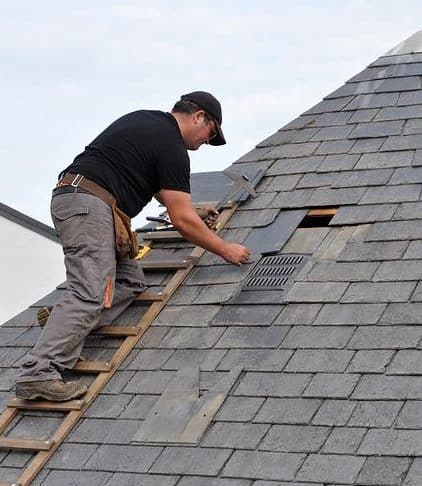
Synthetic Vs Felt Roof Underlayment: Which Should You Choose?
If your roof is old or leaking, it's most likely time for a total roof replacement. While you know you have to choose the right type of asphalt shingles to have installed, you probably haven't thought much about what goes under them. However, the type of roofing underlayment you choose is just as important as your shingles, so you need to understand your choice of materials and the pros and cons of each. To help you make this decision, our roofing contractor in New Jersey is breaking down the difference between synthetic vs felt roof underlayment.
What Is Roof Underlayment?
An asphalt shingle roofing system consists of three key components:

- The roof deck, which is plywood or OSB sheeting that goes over the rafters of the home and serves as the foundation of the system.
- The roof underlayment is a sheet of either reinforced felt or synthetic material that is installed directly over the roof deck to keep it dry. It acts as a secondary layer of protection in the event the shingles leak.
- The shingles are the first line of defense against the elements and are made from asphalt-saturated cellulose or fiberglass.
The two most common types of roofing underlayment are felt or synthetic, and each option has their pros and cons, which we're going to go into greater detail about.
Understanding Felt Roofing Underlayment
Felt underlayment (sometimes called "felt paper" or "tar paper") is the most common and oldest type of underlayment used on homes, but it's name is a bit misleading. The material is actually a blend of cellulose and polyester fibers that is saturated in bitumen and asphalt and coated in a waterproofing material to make it heavier, more durable, and more resistant to moisture.
There are two types of felt roofing underlayment:
- No. 15 felt is lighter in weight, more flexible, and less expensive. However, it's more likely to tear or rip either during installation or if there is damage to the shingles.
- No. 30 felt is much heavier and stiffer, so it provides additional protection against moisture and hail, plus it's less likely to tear or rip. It is a bit more expensive and is more prone to buckling during extreme cold or heat.
Pros of Felt Roof Underlayment
The number one advantage to using felt roof underlayment is the cost. It's significantly less expensive than synthetic and is optimal for homeowners who want to protect their home but need to stick to a budget.
Challenges of Felt Roof Underlayment
Asphalt-saturated felt has to be covered as soon as it's installed on the roof and can't be left exposed for more than a few hours. Otherwise, the oils in the material can dry or leach out, leading to cracking and degradation which reduces its ability to protect the home against water damage. If the underlayment is exposed to moisture, it can buckle and wrinkle, so the shingles won't lay flat against it. This can lead to additional exposure to moisture and damage.
Understanding Synthetic Roofing Underlayment
Synthetic roofing underlayment is a fairly new material and has only been on the market for about 20 years. Made from polymers like polyethylene or polypropylene, this material is rapidly growing in popularity, especially because more shingle manufacturers are requiring synthetic underlayment in order for the warranty to be honored. Like felt underlayment, the synthetic material is nailed directly to the deck to add additional protection under the shingles.
Pros of Synthetic Roof Underlayment
The main benefit of choosing synthetic roof underlayment is that it offers greater resistance to heat and water. It is completely waterproof so in the event that there is damage to the shingles, this material will keep moisture from damaging the roof deck or the interior of your home. Also, it won't buckle, wrinkle, or crack when exposed to UV rays, heat, or cold.
In addition to this, it's lighter in weight, making it easier to install and, because it comes in larger rolls, it offers better coverage with fewer seams than felt underlayment. Again, this minimizes the risk of moisture penetration and water leaks.
Challenges of Synthetic Roof Underlayment
The only real downside to choosing a synthetic roofing underlayment is the price as it's more expensive than felt. However, it does last longer and can be a better investment in the long run, rather than paying for expensive roof repairs to the deck, water damage from leaks, or mold in your attic.
Schedule a Free Estimate for a Roof Replacement in New Jersey Today
If you're in need of a new roof or roof replacement for your home, reach out to our roofing contractor today. We offer several options for roofing underlayment to best meet the needs of your home and your budget as well as high-quality asphalt shingles. To learn more about our services or schedule a free estimate, call us today at (201) 773-0633 or fill out the form below to get started.
